On this page
Bike boxes
Bike boxes improve intersection safety for everyone by giving people biking a dedicated space to wait in front of cars at a red traffic light. Bike boxes are being used in cities all over Canada, including Kitchener, Toronto and Vancouver.
Right-turning drivers must check to see that the bike box and bike lane are clear before turning right. When the traffic light turns green, bicycle riders move through the intersection first.
Guelph has bike boxes in the following locations:
- Gordon Street and Waterloo Avenue
- Stone Road and Chancellor’s Way
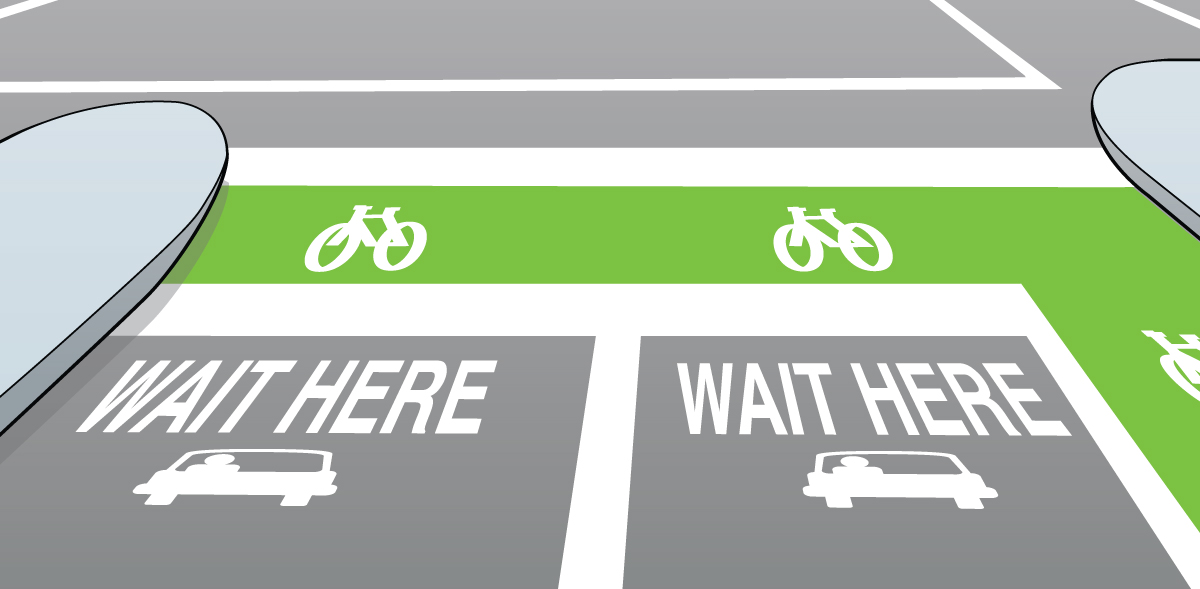
When the traffic signal is green

Approaching a bike box by car
Move through the intersection as usual, sharing the road with people who are biking. When turning right, make sure the bike lane on your right is clear—someone on a bike may have approached from behind you.
Approaching a bike box by bike
Approach the intersection as usual. Use the bike lane to travel straight or turn right. Watch for right-turning vehicles.
When turning left, signal and merge into the left turn lane before the intersection. Proceed through the intersection and into the bike lane.
When the traffic signal is red
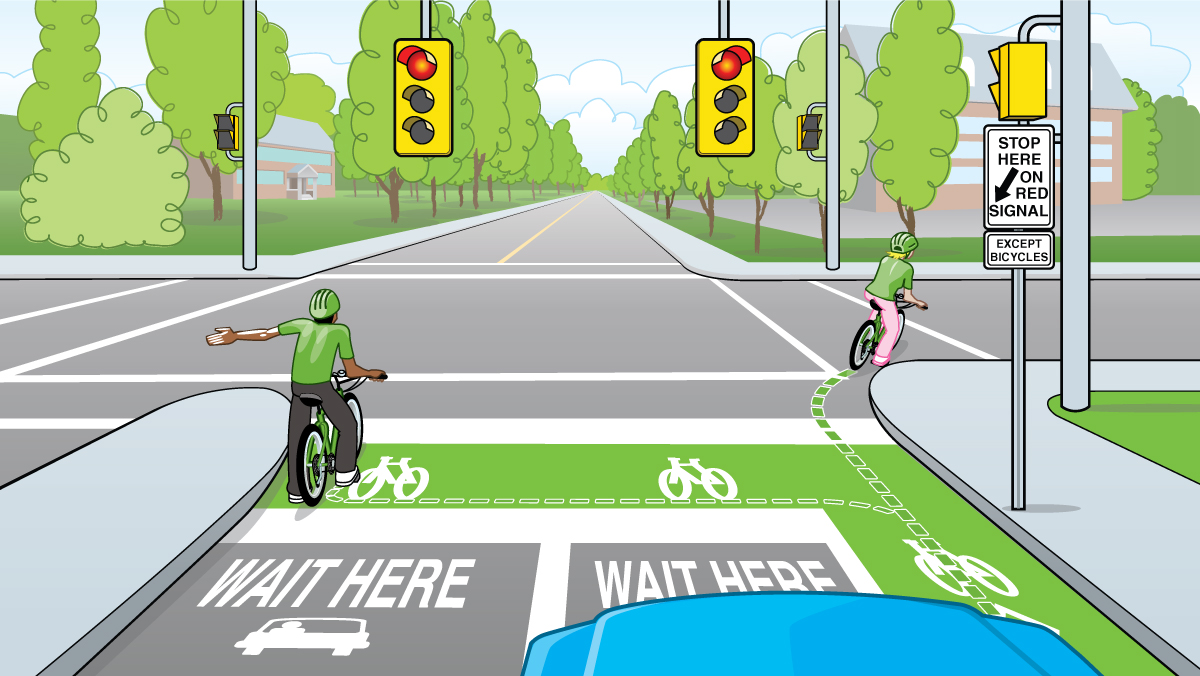
Approaching a bike box by car
Stop at the stop line behind the marked bike box. People on bikes will pull into the bike box in front of you where it’s easy for you to see them. When the light turns green, proceed through the intersection as usual, leaving space for people on bikes to go first.
When turning right on a red light
Stop at the stop line behind the marked bike box. Signal and make sure that the bike box in front of you and the bike lane on your right are clear before turning.
Approaching a bike box by bike
Enter the bike box from the approaching bike lane, watching for right-turning vehicles. Stop in the bike lane to the far right of the bike box.
If you are going straight, stay to the right in the bike lane until the light turns green. This will allow right-turning vehicles to turn around you if they are able to do so safely, and will keep the bike box clear for cyclists turning left to get through.
To prepare for a left turn, signal and move to the left of the bike box. When the light turns green proceed through the intersection and into the bike lane.
When turning right on a red light
Stop in the marked bike lane to the far right of the bike box. Watch for right-turning motorists. Signal and proceed.
Sharrows
Special road markings called sharrows let road users know when the travel lane is shared with bicycles. Sharrows are also used when a bike lane begins or ends. Sharrows show people riding bikes where to ride and remind those driving cars that bicycles should be expected in the same lane.
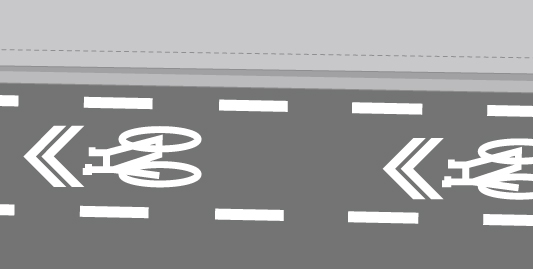
Raised cycle tracks
A paved and separated bike lane, or raised cycle track, gives people riding bikes a dedicated and more comfortable space in which to ride. Sharrows mark where cyclists move into or out of the track. Cycle tracks are being used in Montreal, Vancouver and Toronto.
Multi-use paths
A multi-use path is physically separated from the road where people walking and biking share the path.
Tips for people walking
- Be courteous: keep to the right.
- Be safe: check behind and ahead of you before moving across the pathway or turning.
- Be careful: make eye contact with people driving when crossing the path at driveways and intersections.
Tips for people biking
- Be courteous: yield to pedestrians—be extra careful around bus stops and intersections.
- Be safe: cycle at a safe speed and slow down when approaching intersections.
- Be predictable: sound your bell or call out before passing.
- Be careful: keep an eye out down the road to identify and react to potential hazards in advance.
Tips for people taking the bus
- Be courteous: do not block the path while waiting for the bus.
Tips for people driving
- Be courteous: pathway users have the right of way. Keep the pathway clear and yield to people walking and biking until it’s safe to merge with traffic.
- Be careful: keep a close eye out for people walking and biking when approaching driveways and intersections—people riding bikes may be moving faster than you think. Make eye contact with people walking and biking at driveways and intersections.
Crossrides
What is a crossride
A crossride is a separate lane designed for people on bikes that allows them to stay mounted while crossing intersections. Crossrides are identified by paint markings on pavement that can appear directly beside a crosswalk or combined to save space.

Image from Halton.ca
How to use crossrides
Cyclists

- Cyclists must press the button at the intersection to receive the bicycle green signal
- When the bicycle signal is green, ride carefully across the intersection within the crossride paint markings, watching for left and right turning vehicles
- Travel at a speed that allows you to stop quickly if a vehicle makes a sudden turn
- Obey all traffic signs and signals
- Do not pass other cyclists within the crossrides. When passing pedestrians, ring your bell and pass carefully
Pedestrians


- Cross at the marked crosswalk and watch for vehicles
- Avoid using electronic devices, texting, etc. while crossing the road
- Obey all traffic signs and signals
Drivers
- When making a turn, be extra careful and watch for cyclists and pedestrians who are crossing the intersection
- Yield to cyclists and pedestrians who enter the intersection
- Obey all traffic signs and signals
Crossride locations
- Vanier Drive and College Avenue (July 2022)
- Stone Road and Gordon Street (August 2022)
- Woodlawn Road and Arrow Road (August 2022)
Why do we need crossrides?
The installation of crossrides and bike signals aligns with Guelph’s community plan – moving around freely, and ensures that all road users have access to safely cross intersections and share road space.
Bike Signals
Bike signals are traffic signals for people on bikes. Just like a traffic light for vehicles, or pedestrian signal for people walking, bike signals tell cyclists when it is safe to begin crossing an intersection.

Tips when using bicycle signals:
- Bicycle signals may be timed alongside traffic and pedestrian signals, however, users move at different speeds. Pay attention to the signal that applies to the mode of transportation you are using.
- Bike signals have been installed around Guelph at the following locations:
- Vanier Drive and College Avenue
- Stone Road and Gordon Street
- Woodlawn Road and Arrow Road
- Victoria Road South at Clair Road East
- To ensure the bike network functions safely, and to meet the goals of the Transportation Master Plan and Community Plan, we use measures like signs, signals and pavement markings to support and provide direction to people cycling.
When to follow the bicycle signals:
- The bicycle signals only apply to you when you are biking off the road (e.g., biking on a multi-use path or a cycle track beside a sidewalk). When you are biking on the road, in a traffic lane or a bike lane, please follow the traffic lights for cars.
Protected intersections
Protected intersections help people on bikes turn left without having to change lanes or mix with other traffic. This type of intersection enables two-stage left turns, so people biking move in a similar way to pedestrians. The corner waiting areas and crossrides mean cyclists do not have to dismount and walk their bikes.
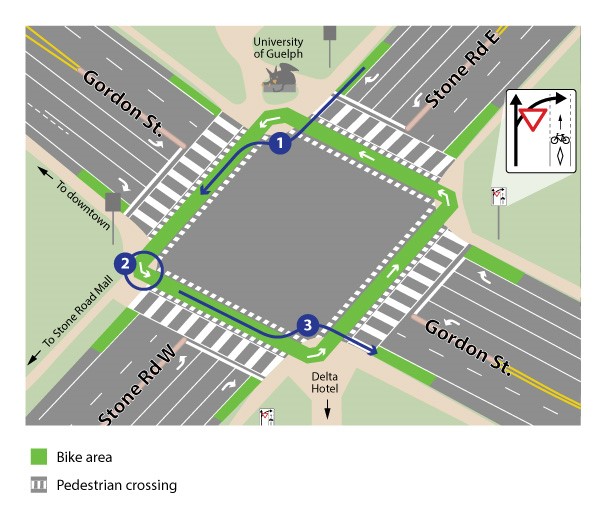
People on bikes who want to turn left
Go straight across the intersection using the green crossride so that other road users see you
Wait in the designated bike space at the corner
Continue across the road towards the bike lane, exiting the green crossride to complete your left turn
Always travel in the direction of the arrows (counter-clockwise) and obey the traffic light signals
Only use the corner waiting area when turning left. You do not need to enter the waiting area if you are travelling straight or have just completed a left turn.
Always use the bike lanes; bicycles are not permitted on the sidewalk.
If you feel comfortable, you can still choose to merge with vehicle traffic to turn left from the left turn lane. Be sure to shoulder check and signal your intent with your arm. The new design gives you the option to use the intersection more like a pedestrian does.
People on bikes who want to go straight
You can travel straight across the intersection without using the green waiting areas. The green waiting areas are for bikes waiting to turn left.
People driving
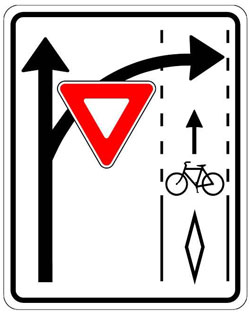
No changes are required for people driving, the protected intersection functions in the same way as all other intersections throughout the City. Vehicles turning right are required to check blind spots, yield to people walking, and biking.
The following sign reminds you to check for and yield to people biking before turning right.
Some people on bikes may choose to merge across lanes of traffic (from the bike lane to the left turn lane) to make a left turn lane. This is allowed.
Penalties
Riding in a crosswalk is subject to a fine under the Highway Traffic Act. Cyclists must stay out of the pedestrian crosswalk area (the white ladder marking), unless they dismount and walk.
Motorists can be fined if they fail to yield to a pedestrian in the crossing.
